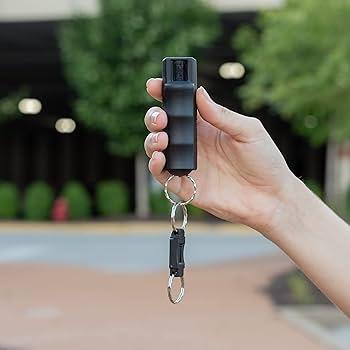Table of Contents
- Campus Carry Pepper Spray Regulations and Compliance Standards
- Effective Training Practices for Safe Pepper Spray Usage on Campus
- Balancing Security and Responsibility Through Clear Policy Development
- Recommendations for Enhancing Awareness and Emergency Response Protocols
- Final Thoughts
Campus Carry Pepper Spray Regulations and Compliance Standards
When carrying pepper spray on campus, adherence to institutional regulations is paramount to ensure both safety and legality. Most universities require users to undergo a verification process confirming that their canisters meet size and formulation specifications as prescribed by local laws. Additionally, compliance standards often mandate that the pepper spray be used strictly for self-defense purposes, with any misuse potentially resulting in disciplinary action. By establishing clear boundaries around possession and application, campuses aim to balance personal security with a safe learning environment.
Key compliance elements typically include:
- Approved container size limits, commonly no larger than 2 ounces.
- Mandatory training sessions or informational briefings on proper use and legal implications.
- Secure storage requirements when not in immediate use, preventing unauthorized access.
- Clear reporting protocols following deployment in self-defense scenarios.
Understanding and respecting these regulations not only promotes responsible carry but also aligns with the broader mission to foster a respectful and secure campus atmosphere.
Effective Training Practices for Safe Pepper Spray Usage on Campus
Implementing a comprehensive training program is essential to ensure responsible and effective use of pepper spray on campus. Such programs should emphasize hands-on demonstrations paired with realistic scenarios that replicate potential campus threats. This approach not only builds confidence but also fosters muscle memory, allowing users to react swiftly and accurately under stress. Additionally, incorporating regular refresher sessions is vital to maintain proficiency, reinforce safety protocols, and update participants on any legal or procedural changes related to campus carry policies.
Successful training goes beyond just operational techniques; it must also address the ethical and legal considerations surrounding pepper spray use. Highlighting proper target zones, avoidance of excessive force, and the importance of de-escalation helps mitigate misuse and campus liability. Key components of effective training often include:
- Clear instruction on device activation and safe handling
- Scenario-based decision-making exercises
- Legal education on campus carry ordinances and self-defense laws
- Post-incident procedures, including reporting and medical assistance
Balancing Security and Responsibility Through Clear Policy Development
Crafting a comprehensive policy around campus carry pepper spray requires a nuanced approach that upholds both safety and individual accountability. Institutions must establish clear guidelines that define who is permitted to carry pepper spray, under what circumstances, and how it should be used responsibly. Incorporating training mandates ensures users understand legal implications, proper deployment techniques, and situational awareness. This not only minimizes accidental misuse but also fosters a culture of respect and preparedness among students and staff alike.
Key components of an effective policy include:
- Eligibility criteria based on age, background checks, and prior training.
- Defined use cases emphasizing defensive use only and prohibiting aggression.
- Mandatory educational sessions that cover both practical handling and legal boundaries.
- Clear reporting procedures following any deployment to ensure accountability and transparency.
Recommendations for Enhancing Awareness and Emergency Response Protocols
To cultivate a safer campus environment where pepper spray is permitted, educational institutions should prioritize comprehensive awareness campaigns targeting students, staff, and faculty. These campaigns can include interactive workshops, digital tutorials, and easily accessible informational materials that highlight proper usage, legal considerations, and potential risks. Incorporating real-life scenarios and testimonials during training sessions can significantly enhance understanding and foster a sense of responsibility among participants. Additionally, visible signage in key campus locations serves as a constant reminder of policies and safety measures, reinforcing a culture of vigilance and preparedness.
Developing a robust emergency response framework is equally crucial. This framework should emphasize clear communication channels and well-practiced coordination between campus security, local law enforcement, and health services. Institutions might consider implementing designated response teams trained specifically to assist with pepper spray incidents, ensuring rapid and effective mitigation. Integrating mobile app alerts for real-time notifications, alongside regular drills, can further empower the campus community to respond calmly and confidently during emergencies. Together, these protocols create a resilient support system that prioritizes the well-being of all campus members.
Final Thoughts
In conclusion, navigating the complexities of campus carry pepper spray policies requires a thoughtful balance between safety, education, and respect for community standards. Proper training ensures that individuals are equipped not only to use pepper spray effectively in emergencies but also to understand the legal and ethical responsibilities that come with it. As campuses continue to evolve their safety protocols, fostering open dialogue and ongoing education will be key to creating environments where everyone feels secure and empowered. Staying informed and prepared is the best way to contribute to a safer campus for all.Check Our Other Blogs
- StunGun – Your Trusted Source for Stun Guns, Laws, and Self-Defense Tips
- PepperSprayLaws – Your Trusted Resource for Pepper Spray Information
- StunGunLaws – Your Trusted Guide to Stun Gun Legality and Safety




